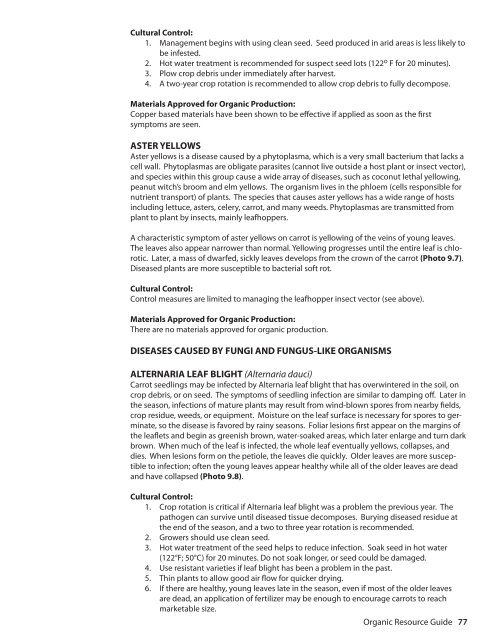Resource Guide for Organic Insect and Disease ... - Cornell University
Resource Guide for Organic Insect and Disease ... - Cornell University
Resource Guide for Organic Insect and Disease ... - Cornell University
You also want an ePaper? Increase the reach of your titles
YUMPU automatically turns print PDFs into web optimized ePapers that Google loves.
Cultural Control:<br />
1. Management begins with using clean seed. Seed produced in arid areas is less likely to<br />
be infested.<br />
2. Hot water treatment is recommended <strong>for</strong> suspect seed lots (122 o F <strong>for</strong> 20 minutes).<br />
3. Plow crop debris under immediately after harvest.<br />
4. A two-year crop rotation is recommended to allow crop debris to fully decompose.<br />
Materials Approved <strong>for</strong> <strong>Organic</strong> Production:<br />
Copper based materials have been shown to be effective if applied as soon as the first<br />
symptoms are seen.<br />
ASTER YELLOWS<br />
Aster yellows is a disease caused by a phytoplasma, which is a very small bacterium that lacks a<br />
cell wall. Phytoplasmas are obligate parasites (cannot live outside a host plant or insect vector),<br />
<strong>and</strong> species within this group cause a wide array of diseases, such as coconut lethal yellowing,<br />
peanut witch’s broom <strong>and</strong> elm yellows. The organism lives in the phloem (cells responsible <strong>for</strong><br />
nutrient transport) of plants. The species that causes aster yellows has a wide range of hosts<br />
including lettuce, asters, celery, carrot, <strong>and</strong> many weeds. Phytoplasmas are transmitted from<br />
plant to plant by insects, mainly leafhoppers.<br />
A characteristic symptom of aster yellows on carrot is yellowing of the veins of young leaves.<br />
The leaves also appear narrower than normal. Yellowing progresses until the entire leaf is chlorotic.<br />
Later, a mass of dwarfed, sickly leaves develops from the crown of the carrot (Photo 9.7).<br />
<strong>Disease</strong>d plants are more susceptible to bacterial soft rot.<br />
Cultural Control:<br />
Control measures are limited to managing the leafhopper insect vector (see above).<br />
Materials Approved <strong>for</strong> <strong>Organic</strong> Production:<br />
There are no materials approved <strong>for</strong> organic production.<br />
DISEASES CAUSED BY FUNGI AND FUNGUS-LIKE ORGANISMS<br />
ALTERNARIA LEAF BLIGHT (Alternaria dauci)<br />
Carrot seedlings may be infected by Alternaria leaf blight that has overwintered in the soil, on<br />
crop debris, or on seed. The symptoms of seedling infection are similar to damping off. Later in<br />
the season, infections of mature plants may result from wind-blown spores from nearby fields,<br />
crop residue, weeds, or equipment. Moisture on the leaf surface is necessary <strong>for</strong> spores to germinate,<br />
so the disease is favored by rainy seasons. Foliar lesions first appear on the margins of<br />
the leaflets <strong>and</strong> begin as greenish brown, water-soaked areas, which later enlarge <strong>and</strong> turn dark<br />
brown. When much of the leaf is infected, the whole leaf eventually yellows, collapses, <strong>and</strong><br />
dies. When lesions <strong>for</strong>m on the petiole, the leaves die quickly. Older leaves are more susceptible<br />
to infection; often the young leaves appear healthy while all of the older leaves are dead<br />
<strong>and</strong> have collapsed (Photo 9.8).<br />
Cultural Control:<br />
1. Crop rotation is critical if Alternaria leaf blight was a problem the previous year. The<br />
pathogen can survive until diseased tissue decomposes. Burying diseased residue at<br />
the end of the season, <strong>and</strong> a two to three year rotation is recommended.<br />
2. Growers should use clean seed.<br />
3. Hot water treatment of the seed helps to reduce infection. Soak seed in hot water<br />
(122°F; 50°C) <strong>for</strong> 20 minutes. Do not soak longer, or seed could be damaged.<br />
4. Use resistant varieties if leaf blight has been a problem in the past.<br />
5. Thin plants to allow good air flow <strong>for</strong> quicker drying.<br />
6. If there are healthy, young leaves late in the season, even if most of the older leaves<br />
are dead, an application of fertilizer may be enough to encourage carrots to reach<br />
marketable size.<br />
<strong>Organic</strong> <strong>Resource</strong> <strong>Guide</strong> 77







